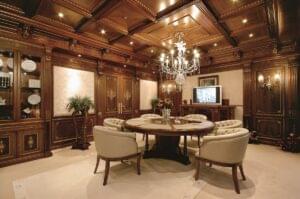Children enjoy to explore their surroundings, and by climbing, they can get to toys or objects that are out of their grasp. Free-standing furniture, appliances, and televisions are frequently the ideal height for climbing but they are unstable and easily tumble if a youngster is underneath, leading to serious injury or even death.
Every year, on average, two kids pass away from furniture and television accidents, and hundreds more have injuries. Most tip-over injuries involve a youngster under the age of 4, and children under the age of 10 are most at risk.
Human nature tends to make us believe that awful things only happen to other people but in this instance, ignorance is not bliss. I’m about to give you a great present and I hope it motivates you to read on and take action in your home to prevent a tip-over.
Principal sources of harm
Unsecured, unstable objects like bookcases, chests of drawers, cabinets, closets, and free-standing mirrors are frequently prone to tumbling. Due to the crushing weight of such heavy furniture and household belongings, asphyxiation accounts for the majority of furniture tip-over fatalities. Further harm brought on by furniture tip-overs may include:
- fractures, dislocations, or fractured bones
- any scrapes or open sores
- chest (crushing) injuries
- internal wounds
- amputation
- brain damage
Enhancing security
Furniture tip-over deaths and injuries can be avoided with the use of quick, simple, and inexpensive actions. 100% of tip-over occurrences can be avoided with a little work. To secure your house:
- Using the proper anchoring methods, fasten televisions and tall or unstable furniture to wall studs or flooring. Hardware stores and furniture retailers also sell brackets, braces, and wall straps that can be used.
- When installing any supplied anchoring equipment with new furniture or appliances, follow the installation instructions that are provided.
- Put child-resistant locks on drawers to stop children from opening them and using them as ladders.
- Keep all drawers closed when not in use and only open one at a time.
- Heavy objects should be kept in lower drawers or shelves of bookcases, closets, or cabinets.
- Never install a TV or any heavy items on top of a chest of drawers or other piece of furniture that isn’t designed to house a television.
- Kids should not be allowed to climb on furniture.
- Do not place enticing items on top of furniture, such as toys, candies, or remote, as this may encourage climbing.
- Avoid putting unstable furniture near play areas or in children’s bedrooms.
- Urge people to secure items around their residences, especially if your youngsters frequently go there (e.g. grandparents).
How to mount anchoring equipment
To ensure that any anchor attachments are sturdy enough to support the item, you must take into account the weight and dimensions of the furniture while trying to install an anchoring device. Using the appropriate anchoring method for the wall or flooring material is also crucial. For masonry, plasterboard, or wood studs, various screw kinds are available. Ask for help from a nearby hardware store.
Consult a professional (such as a handyman or carpenter) who can install or advise you correctly if you are unsure how to install an anchoring device or what anchor you need to buy.
Property rentals
While installing anchor devices to the walls or floors of a rental property requires authorization from the landlord or agent, this shouldn’t stop you from anchoring your furniture. Once the tenancy is over, make a promise to fix any damage (such as drill holes) brought on by the installation of any anchor devices. In order to have a written record of your agreement, you should obtain consent.
Advice on new furniture purchases
Ask salespeople for recommendations on safer solutions for homes with young children when purchasing furniture. Also, think about the following:
- Choose low-set storage furniture with a robust, wide base that rests firmly on the ground (rather than on legs).
- Look for furniture that includes instructions on safety and the necessary tools for securing it to the wall or the floor.
- Before buying, try out the furniture in the store (e.g. pull out a drawer and apply a little pressure to check that it is stable and ensure drawers cannot be pulled out easily).
Legal prerequisites
Few (only 12%) of the stores examined by Australia’s safety regulators that sold furniture that needed anchors actually provided them. In order to improve safety and lower the risk of tip-overs, the Australian Competition and Consumer Commission (ACCC) has encouraged suppliers and retailers to make sure that consumers are provided with the proper anchoring devices, better in-store signage is displayed, and warning labels are attached to products.
Essentials to keep in mind
- Always use the proper equipment to anchor furniture and televisions to the wall or the floor.
- Kids should not be allowed to climb on furniture.
- Install child-resistant locks on drawers and place heavy objects on the lower shelves or drawers of bookcases, closets, or cabinets.
For additional details
- Fact sheet about kids’ health: Security: Within the house
- For more information on furniture tip-overs, visit the Product Safety website of the ACCC.




